Introduction
Passion Fruit and Its Health Benefits
Passion fruit is a short-lived evergreen perennial vine species, native to the region extending from southern Brazil to Paraguay to northern Argentina. It is cultivated commercially in tropical and subtropical areas for its aromatic and sweet fruit. When freshly harvested, passion fruit is refreshingly tart. As the fruit ripens, it becomes sweeter and more complex in flavor—a flavor comparable to that of citrus, melon, pineapple, and kiwi. Taut and shiny when freshly picked, a passion fruit’s skin shrivels over time (Figure 1). The fruit pulp and small seeds can be eaten from halved fruit with a spoon; or the pulp can be made into ice cream, juice, nectars, jams, and used in cakes.
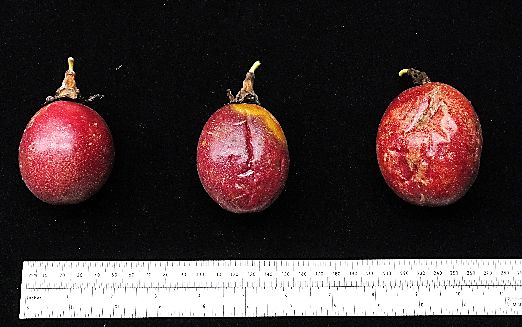
Credit: Ellen Garcia, UF/IFAS
The demand for passion fruit has increased thanks to their unique flavor, aroma, and functional composition of phytochemicals. Phytochemicals are defined as bioactive nutrient chemicals found in fruits, vegetables, grains, and other plant foods. These chemicals may provide desirable health benefits that reduce the risk of major chronic diseases. Some phytochemicals have the potential to provide physiological benefits, deeming them “nutraceuticals” (Cisneros-Zevallos 2021). Passion fruit contains essential vitamins and minerals such as vitamin A, vitamin C, riboflavin, niacin, iron, potassium, zinc, and magnesium (Figure 2) (Pham-Huy, He, and Pham-Huy 2008). Passion fruit can potentially be of high economic value for Florida because of its suitability for tropical climates, high price, and nutrient density, which has great benefits for human health. This publication can help consumers understand passion fruit’s appeal and help Florida producers and marketers to understand the competitive advantages of passion fruit as an emerging industry for Florida.
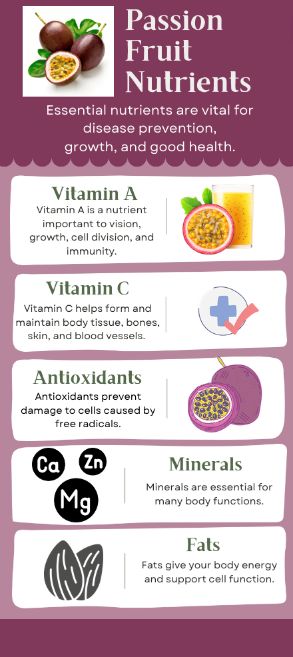
Credit: Ellen Garcia, UF/IFAS
Potential Cultivars for Florida Growers
There are more than 525 species in the Passifloraceae family. Passiflora is the most prominent genus in this family, with approximately 355 species in 22 subgenera. There are only a few species of these plants that are cultivated commercially (Silva and Souza 2020). Three passion fruit species that are commercially grown throughout the world are described below.
Passiflora edulis
The most widely grown variety in south Florida, P. edulis, has a flower with a distinctive corona (Figure 3) and a purple-skinned fruit (Figure 4). Blooming in a wide variety of shapes and colors, P. edulis hybrids can be cultivated as ornamental plants. Hybrids can be created, in part, because of the plant’s self-compatibility and thus high yield. Passion fruit is mainly pollinated by honeybees in Florida, since the carpenter bees that pollinate this crop elsewhere are mostly absent from south Florida fields. After harvesting, the fruit loses moisture quickly, often becoming shriveled by the time it reaches supermarket shelves; it is also susceptible to several postharvest diseases. A portion of the fruit is discarded at the packinghouse because of disease or blemishes. A solution to mitigate this financial loss is to use the fruit for value-added products since they are not marketable due to blemishes, but the pulp remains fresh.
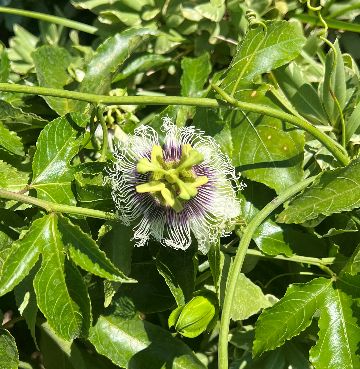
Credit: Ellen Garcia, UF/IFAS
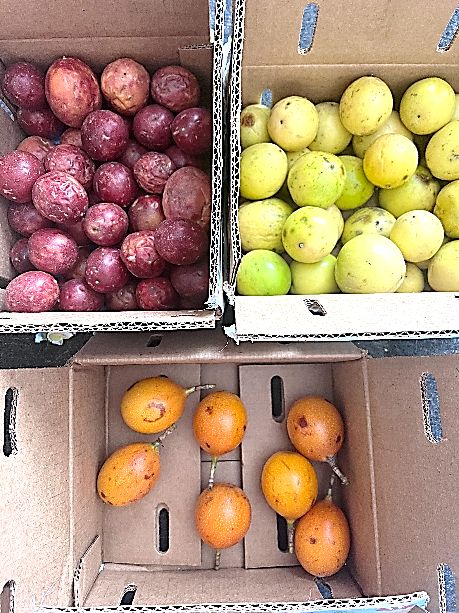
Credit: Ellen Garcia, UF/IFAS
There is a need to develop improved cultivars that can be expected to reliably produce in Florida and support a growing industry (Anderson et al. 2022). The cultivar commonly known as “Possum Purple” is a cross between purple and yellow passion fruit. This is demonstrated by the fact that the seedlings of ‘Possum Purple’ were segregated for yellow and purple fruit color (Knight 1992).
Passiflora edulis f. flavicarpa
The yellow-skinned P. flavicarpa (Figure 4) is the most economically important variety of passion fruit cultivated worldwide and accounts for more than 95% of the passion fruit produced in Brazil, which is the world’s largest passion fruit producer and consumer. In Brazil, the fruit largely goes toward juice production (Silva and Souza 2020). Typically, the yellow passion fruit exhibits self-incompatibility. Therefore, it relies on the assistance of pollinators to cross-pollinate with other varieties and increase the fruit’s yield.
Passiflora ligularis
P. ligularis is commonly known as sweet granadilla (figure 4). The native range of sweet granadilla is in the Andes Mountains between Bolivia and Venezuela. Peru is the fruit’s main producer, but this variety grows anywhere from Mexico to as far south as northern Argentina. Outside of its native range, it grows in Florida, Hawaii, New Zealand, Papua New Guinea, Australia, China, Sri Lanka, Jamaica, Indonesia, and in the tropical highlands of East Africa and South Africa. The leading producers of sweet granadilla are Peru, Venezuela, Colombia, Ecuador, Brazil, South Africa, and Kenya. The main importing countries include the United States, Canada, and Europe (Lim 2012).
This fruit naturally grows in tropical and subtropical mesic or humid forests, including tropical highland forests. It can commonly be found in the Andes mountains and grows at high altitudes ranging from 1800–2400m above sea level (Espinosa et al 2018). The plant is intolerant to heat but can withstand short periods of light frost. It grows on light clay soils that are loamy to well-drained and on moist volcanic soils, like those in Indonesia and Hawaii. The soil pH typically ranges from 6 to 7.5 (Lim 2012).
Sweet granadilla has a thick and brittle orange peel that may contribute to its extended shelf life compared to other passion fruit species. In a shelf life study conducted on cultivars of this species found in the northeast region of India, the maximum days at room temperature lasted from 12–14 days (Shankar et al. 2020). The flavor of this cultivar is completely sweet compared to the other two cultivars discussed in this article, which have more of a tart flavor (Table 1).
Table 1. Potential distinguishing characteristics between Passiflora edulis, Passiflora flavicarpa, and Passiflora ligularis.
Phytochemical Properties and Potential Benefits
Passion fruit is high in vitamin C (ascorbic acid), vitamin E (tocopherols), and carotenoids (alpha-carotene, beta-carotene, beta-cryptoxanthin, lutein, zeaxanthin, and lycopene) which have been shown to provide antioxidant capabilities (Correa et al. 2016; Pertuzzati et al. 2015). An overload of free radicals and oxidants can be produced from normal cell metabolism or from external sources such as pollution, cigarette smoke, radiation, or medication; and this accumulation generates oxidative stress. This process contributes to the development of chronic and degenerative illness such as cancer, autoimmune disorders, premature aging, cataracts, rheumatoid arthritis, and cardiovascular and neurodegenerative diseases (Pham-Huy, He, and Pham-Huy 2008; Pisoschi et al. 2021; Pizzino et al. 2017). Antioxidant activity has been associated with decreases in DNA damage, a reduction in lipid peroxidation, maintenance of immune function, and the prevention of the development of the aforementioned diseases (Pertuzzati et al. 2015; Vassalle 2020). In a study on total polyphenol contents of tropical fruit in France, Septembre-Malaterre et al. (2016) detected the highest antioxidant activity in passion fruit—the other fruits (including mango, pineapple, banana, and litchi) exerting lower free radical scavenging activities. Passion fruit provides oxidative supplementation that may support human health (Thokchom and Mandal 2017).
Like its juice, passion fruit’s peel, seeds, and leaves potentially have health benefits (Figure 5). The peel is a byproduct of the juice industry and thus represents an opportunity: the peel can be used as flour or as a hydrocolloid (pectin) in food. Pectin can better stabilize, emulsify, and thicken than can xantham gum, guar gum, and carrageenan (Coelho et al. 2017; Freitas et al. 2020). β-glucosidase— found in the passion fruit peel— is an enzyme with diverse biotechnological applications in food, surfactant, biofuel, and agricultural industries (Almeida et al. 2015; Singh et al. 2016). Passionfruit seeds contain an oil that is a good source of omega-3 and omega-6 essential fatty acids and has potential as a value-added product. Passionfruit seed oil, which the beauty industry calls "maracuja oil," is made from agro-industrial waste left over from processing the fruit to make juice or pulp. Maracuja oil can be used in lotions, creams, and hair-care products (Pereira et al. 2019). Piceatannol (3,4,3',5'-tetrahydroxy-trans-stilbene) is an antioxidant discovered to be present in passion fruit seeds in large amounts; this compound is the major component responsible for the effects observed on melanogenesis and collagen synthesis (Matsui et al. 2010). Young, tender, passion fruit leaves contain vitamin A and niacin, and when dried, the leaves are used for calming teas and herbal remedies (Jeyasekaran and Deepa 2021).
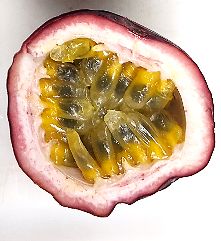
Credit: Ellen Garcia, UF/IFAS
Historically, species in the Passiflora family have been used in folk medicine or as sedatives and anxiolytics (for treating symptoms of anxiety) (Correa et al. 2016). Seed oil from the fruits are currently being used in the pharmaceutical and cosmetics industries as well (Cesar et al. 2022). Passion fruit is a suitable source of vitamins, minerals, and fatty acids because of its rich phytochemical properties. The pulp has been found to have potential antioxidant and anti-inflammatory properties (Khongrum et al. 2022) that aid in mitigating the effects of free radicals. Free radicals can build up in the cells and cause damage to other molecules such as DNA, lipids, and proteins, increasing the risk of chronic diseases (Sharidi-Rad et al. 2020). Antioxidants scavenge free radicals from the body cells and prevent or reduce the damage caused by free radicals (Zeb 2020). In summary, the nutritional and phytochemical composition of passion fruit is rich in antioxidants and also has potential to serve as a source of ingredients which promote health and well-being (Fonseca et al. 2022).
Suggestions for Growers
Passion fruit is a vigorous perennial vine with trilobed leaves that require a trellising system (Figure 6). It can grow up to 35 ft. per year. The fruit is typically round or egg shaped and 3–3.5 in. long. The plant—which pertains to zones 10 to 12—should be exposed to full sun and watered daily to prevent fruit dropping and leaf withering. Use the USDA hardiness zone search tool to find the zone for a specific address: https://planthardiness.ars.usda.gov/. Both Florida and temperate zones would benefit from a cold-hardy variety that can withstand frost; its incorporation would be a stimulus for the agricultural industry. The vine grows best in temperatures of 65°F to 90°F; exposure to temperatures of 32°F to 59°F can cause chilling injury (Bailey et al. 2021). During freezes, producers may be able to protect crops with overhead sprinklers. This method has been used successfully to protect vines in temperatures as cold as 23°F: when the water freezes, heat energy is released, protecting the vines from freezing. High tunnels offer another means of frost protection (Bailey et al. 2021).
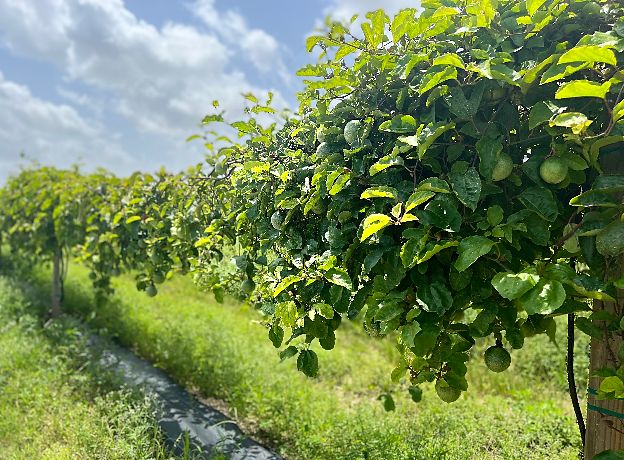
Credit: Ellen Garcia, UF/IFAS
Fruits can be expected to ripen 70–80 days after pollination. The soil should be well drained. Passion fruit may also grow well in 3-gallon pots for home use, if desired. The soil should have a pH of 6–7.5 (Bailey et al. 2021). Mulch 2–4 inches thick can be added around the base of the vine to prevent weed competition and retain soil moisture. Passiflora vines can be grown from seeds, cuttings, air layering, and grafting. Seeds can be planted and will germinate within two to three weeks after being removed from the fruit; soaking the seed in water before planting it will hasten germination.
Vines produce flowers at maturity, which can take about 6 months to a year. Excessive fertilizer input will contribute to vegetative growth rather than flowering. Therefore, a fertilizer input of granular slow-release N-P-K (14-14-14) is suggested. With insufficient cross-pollination by bees, hand pollination can be done using clean gloves or a paint brush to transfer pollen from the anther of one flower to the stigma of another flower (Rezazadeh et al. 2020). Lack of pollination can result in fruit that is incompletely filled with seeds and pulp. Each fertile seed in the fruit is the result of fertilization of one embryo sac by one pollen grain. The greater the number of viable seeds within a fruit, the larger the fruit is and the greater its juice content (Knight 1992).
The most serious problem in growing passion fruit vines is its susceptibility to fungal diseases that attack the root, stem, leaf, and fruit. Passion fruit also serves as a host plant for Gulf fritillary (Agraulis vanillae) and variegated fritillary (Euptoieta claudia), the latter of which feeds on plant tissues (Figure 7).
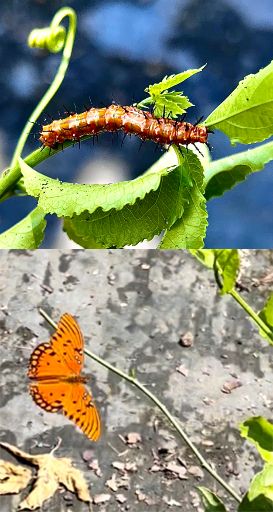
Credit: Ellen Garcia, UF/IFAS
For more information on passion fruit horticultural practices and potential pathogen information please visit the following publications:
- “The Passion Fruit in Florida”
- “Disease Control in Passion Fruit (Passiflora edulis)”
- “Studies on Post-harvest Quality of Passion Fruit”
- “Post-harvest Conservation of Passiflora alata Fruit Under Ambient and Refrigerated Condition”
Economics of the Passion Fruit Industry
The economic interest in passion fruit species emerged due to the beauty of their flowers, their active medicinal properties, their desirable taste and obtainable derivatives, and the fact that their essential oils can be extracted for the cosmetics industry. The domestic market for passion fruit is currently at $35–$58 per 10-pound carton; and the market is expanding to commodity shipping to cities like Chicago, Detroit, Los Angeles, New York, and Philadelphia. According to the 2017 U.S. Census of Agriculture, the total number of farms of bearing age was 257 on a total of 85 acres, with an average farm on less than a 1/3 acre. In 1994, the average yield per acre used for passion fruit was 2,200–4,400 lb. (Knight and Sauls 1994). Each acre can have about 360 passion fruit plants that are appropriately spaced from each other. In the local, Floridian market, a box/flat of 4–6 lb. of passion fruit can go for approximately $40.80. This high selling price is an attractive and important factor for prospective farmers to consider. Daily updates to passion fruit import data can be found here. Brazil has the largest market of passion fruit (accounts for 50%–60% of the world’s production). This market accounted for 248 million dollars’ worth of production in 2016 (Wijeratnam 2016). A study conducted in Ecuador in 2021 found that the benefit/cost ratio obtained was 0.76 and 2.84 for the first year and the second year, respectively, indicating that for every dollar invested, there is a profit of $3.60 (Quito-Leon et al. 2021).
Summary
There is an abundance of opportunity for passion fruit to meet the demands of south Florida’s market. P. edulis, P. flavicarpa, and P. ligularis are a few of the Passiflora species that are adapted for growth in Florida. These crops contain significant amounts of vitamins and minerals as a good source to meet nutritional daily values and have been proven to positively affect health. Using proper horticultural techniques will allow for vigorous, high yield crops. Florida would greatly benefit from breeding efforts focused on self-compatible cultivars that exhibit high yield and well-filled fruits, disease resistance, extended shelf life enabling long distance transportation, and an ability to withstand light frost. Efforts should also be made to study the use of cold protection techniques to protect from freezing temperatures.
References
Almeida, J. M., V. A. Lima, P. C. Giloni-Lima, and A. Knob. 2015. “Passion Fruit Peel as Novel Substrate for Enhanced β -Glucosidases Production by Penicillium verruculosum: Potential of the Crude Extract for Biomass Hydrolysis.” Biomass and Bioenergy 72: 216–226. https://doi.org/10.1016/j.biombioe.2014.11.002
Alves, J. S. F., J. I. Marques, D. P. Demarque, L. R. F. Costa, J. G. Amaral, N. P. Lopes, A. A. Silva-Júnior. 2020. “Involvement of Isoorientin in the Antidepressant Bioactivity of a Flavonoid-Rich Extract from Passiflora edulis f. Flavicarpa Leaves.” Revista Brasileira de Farmacognosia 30(2): 240–250. https://doi.org/10.1007/s43450-020-00003-x
Anderson, J.D., R. F. Vidal, M. Brym, E. T. Stafne, M. F. R. Resende Jr., A. P. Viana, and A. H. Chambers. 2022. “Genotyping-by-Sequencing of Passion Fruit (Passiflora spp.) Generates Genomic Resources for Breeding and Systematics.” Genetic Resources and Crop Evolution 69: 2769–2786. https://doi.org/10.1007/s10722-022-01397-4
Angel-Isaza, J., J. C. Carmona-Hernandez, W. Narváez-Solarte, and C. H. Gonzalez-Correa. 2021. “Polyphenols from Passiflora ligularis Regulate Inflammatory Markers and Weight Gain.” Biomolecular Concepts 12(1): 36–45. https://doi.org/10.1515/bmc-2021-0005
Anusooriya, P., D. Malarvizhi, V. K. Gopalakrishnan, and K. Devaki. 2014. “Antioxidant and Antidiabetic Effect of Aqueous Fruit Extract of Passiflora ligularis Juss. on Streptozotocin Induced Diabetic Rats.” International Scholarly Research Notices 2014: 1–10. https://doi.org/10.1155/2014/130342
Bailey, M., A. Sarkhosh, A. Rezazadeh, J. Anderson, A. Chambers, and J. H. Crane. 2021. “The Passion Fruit in Florida: HS1406, 1/2021.” EDIS 2021 (1). https://doi.org/10.32473/edis-hs1406-2021
Cesar, Marta Bernardo, Sandra Maria Barbalho, Karina Quesada, Rakesh Kumar Joshi, Adriana Maria Ragassi Fiorini, Claudia C Teixeira, Lucas Fornari Laurindo, et al. 2022. “Possible Industrial Applications of Passion Fruit Oil.” International Journal of Development Research. 12(2): 53855–53858. https://doi.org/10.37118/ijdr.23942.02.2022
Cisneros-Zevallos, L. 2021. “The Power of Plants: How Fruit and Vegetables Work as Source of Nutraceuticals and Supplements.” International Journal of Food Sciences and Nutrition. 72(5): 660–664. https://doi.org/10.1080/09637486.2020.1852194
Coelho, E. M., R. G. Gomes, B. A. S. Machado, R. S. Oliveira, M. S. Lima, L. C. Azêvedo, and M. A. U. Guez. 2017. “Passion fruit Peel Flour—Technological Properties and Application in Food Products.” Food Hydrocolloids. 62: 158–164. https://doi.org/10.1016/j.foodhyd.2016.07.027
Corrêa, R. C. G., R. M. Peralta, C. W. I. Haminiuk, G. M. Maciel, A. Bracht, and I. C. F. R. Ferreira. 2016. “The Past Decade Findings Related with Nutritional Composition, Bioactive Molecules and Biotechnological Applications of Passiflora spp. (Passion Fruit).” Trends in Food Science & Technology. 58: 79–95. https://doi.org/10.1016/j.tifs.2016.10.006
Espinosa, D. S., L. M. Melgarejo, M. S. Hernández, S. E. Melo, and J. P. Fernández-Trujillo. 2018. “Physiological and Biochemical Characterization of Sweet Granadilla (Passiflora ligularis JUSS) at Different Locations.” Acta Horticulturae. 1194: 1459–64. https://doi.org/10.17660/ActaHortic.2018.1194.204
Freitas, C. M. P., R. C. S. Sousa, M. M. S. Dias, and J. S. R. Coimbra. 2020. “Extraction of Pectin from Passion Fruit Peel.” Food Engineering Reviews. 12(4): 460–472. https://doi.org/10.1007/s12393-020-09254-9
Fonseca, A. M. A., M. V. Geraldi, M. R. M. Junior, A. J. D. Silvestre, and S. M. Rocha. 2022. “Purple Passion Fruit (Passiflora edulis f. edulis): A Comprehensive Review on the Nutritional Value, Phytochemical Profile and Associated Health Effects.” 111665. Food Research International. 160: 1–24. https://doi.org/10.1016/j.foodres.2022.111665
Jeyasekaran, P., and M. Deepa. 2021. “A Study on the Identification and Comparison of Functional Components in Different Species of Passion Fruit Vine Leaves.” Journal of Pharmaceutical Research International. 33(58B): 501–507. https://doi.org/10.9734/jpri/2021/v33i58B34230
Knight, R. J. 1992. “Characters Needed for Commercially Successful Passion Fruit.” 3. Proceedings of the Annual Meeting of the Florida State Horticultural Society. 105: 280–282. https://journals.flvc.org/fshs/article/download/92925/89114/0
Knight Jr., R. J., and J. W. Sauls. 1994. “The Passion Fruit: HS60, 4/94.” EDIS 1994. https://ufdc.ufl.edu/IR00003395/00001
Khongrum, J., P. Yingthongchai, K. Boonyapranai, W. Wongtanasarasin, N. Donrung, W. Sukketsiri, A. Prachansuwan, and P. Chonpathompikunlert. 2022. “Antidyslipidemic, Antioxidant, and Anti-Inflammatory Effects of Jelly Drink Containing Polyphenol-Rich Roselle Calyces Extract and Passion Fruit Juice with Pulp in Adults with Dyslipidemia: A Randomized, Double-Blind, Placebo-Controlled Trial.” Oxidative Medicine and Cellular Longevity. 2022: 4631983. https://doi.org/10.1155/2022/4631983
Lim, T. K. 2012. “Passiflora ligularis.” In Edible Medicinal and Non-Medicinal Plants: Volume 4, Fruits, edited by T. K. Lim, 174–177. Netherlands: Springer. https://doi.org/10.1007/978-94-007-4053-2_23
Matsui, Y., K. Sugiyama, M. Kamei, T. Takahashi, T. Suzuki, Y. Katagata, and T. Ito. 2010. “Extract of Passion Fruit (Passiflora edulis) Seed Containing High Amounts of Piceatannol Inhibits Melanogenesis and Promotes Collagen Synthesis.” Journal of Agricultural and Food Chemistry. 58(20): 11112–11118. https://doi.org/10.1021/jf102650d
Pereira, M.G., G. M. Maciel, C. W. I. Haminiuk, F. Bach, F. Hamerski, A. Paula Scheer, and M. L. Corazza. 2019. “Effect of Extraction Process on Composition, Antioxidant and Antibacterial Activity of Oil from Yellow Passion Fruit (Passiflora edulis Var. Flavicarpa) Seeds.” Waste and Biomass Valorization. 10(9): 2611–2625. https://doi.org/10.1007/s12649-018-0269-y
Pertuzatti, P.B., M. Sganzerla, A. C. Jacques, M. T. Barcia, and R. C. Zambiazi. 2015. “Carotenoids, Tocopherols and Ascorbic Acid Content in Yellow Passion Fruit (Passiflora edulis) Grown under Different Cultivation Systems.” LWT - Food Science and Technology. 64(1): 259–263. https://doi.org/10.1016/j.lwt.2015.05.031
Pham-Huy, L.A., H. He, and C. Pham-Huy. 2008. “Free Radicals, Antioxidants in Disease and Health.” International Journal of Biomedical Science: IJBS. 4(2): 89–96. https://www.ncbi.nlm.nih.gov/pmc/articles/PMC3614697/
Pisoschi, A. M., A. Pop, F. Iordache, L. Stanca, G. Predoi, and A. I. Serban. 2021. “Oxidative Stress Mitigation by Antioxidants—an Overview on their Chemistry and Influences on Health Status. European Journal of Medicinal Chemistry. 209: 112891. https://doi.org/10.1016/j.ejmech.2020.112891
Pizzino, G., N. Irrera, M. Cucinotta, G. Pallio, F. Mannino, V. Arcoraci, F. Squadrito, D. Altavilla, and A. Bitto. 2017. “Oxidative Stress: Harms and Benefits for Human Health.” Oxidative Medicine and Cellular Longevity 2017: 8416763. https://doi.org/10.1155/2017/8416763
Quito-León, I. E. P., and S. García-Hevia. 2021. “Economic and Productive Evaluation in Passion Fruit Production, Zone Vega Rivera, El Oro.” Revista Ciencias Técnicas Agropecuarias. 30(2): 86-94. https://www.redalyc.org/articulo.oa?id=93267412009
Rezazadeh, A., M. T. Bailey, and A. Sarkhosh. 2020. “Passion Fruit Problems in the Home Landscape: HS1397, 11/2020.” EDIS 2020. (6). https://doi.org/10.32473/edis-hs1397-2020
Saravanan, S., & T. Parimelazhagan. 2014. “In vitro Antioxidant, Antimicrobial and Anti-Diabetic Properties of Polyphenols of Passiflora ligularis Juss. Fruit Pulp.” Food Science and Human Wellness. 3(2): 56–64. https://doi.org/10.1016/j.fshw.2014.05.001
Septembre-Malaterre, A., G. Stanislas, E. Douraguia, and M. P. Gonthier. 2016. “Evaluation of Nutritional and Antioxidant Properties of the Tropical Fruits Banana, Litchi, Mango, Papaya, Passion Fruit and Pineapple Cultivated in Réunion French Island.” Food Chemistry. 212(1): 225–233. https://doi.org/10.1016/j.foodchem.2016.05.147
Sharifi-Rad, M., N. V. Anil Kumar, P. Zucca, E. M. Varoni, L. Dini, E. Panzarini, J. Rajkovic, et al. 2020. “Lifestyle, Oxidative Stress, and Antioxidants: Back and Forth in the Pathophysiology of Chronic Diseases.” Frontiers in Physiology. 11: 1–21 https://doi.org/10.3389/fphys.2020.00694
Shanker, K., R. Singh, T. Annu, S. W. Haokip, O. Moyong, A. G. Devi, B. Kavyashree, K. H. Anush Sheikh, and Raju Debbarma. 2020. “Shelf-Life of Passiflora ligularis A. Juss, Passiflora Quadrangularis L. Passifloria Edulist Sim and Passiflora Edulis f. Flavicarpa at Ambient Room Temperature Found in Northeast Region of India.” International Journal of Current Microbiology and Applied Sciences. 9(7): 3040-43. https://doi.org/10.20546/ijcmas.2020.907.358
Silva, G. S., and M. M. Souza. 2020. “Origin of the Cultivated Passion Fruit Passiflora edulis f. flavicarpa and Genomic Relationships among Species of the Subgenera Decaloba and Passiflora.” Plant Biology. 22(3): 533–540. https://doi.org/10.1111/plb.13100
Singh, G., A. K. Verma, and V. Kumar. 2016. “Catalytic properties, functional attributes and industrial applications of β-Glucosidases.” Biotech 6(3): 3. https://doi.org/10.1007/s13205-015-0328-z
Soumya, R. S., K. Binu Raj, and A. Abraham. 2021. “Passiflora edulis (var. Flavicarpa) Juice Supplementation Mitigates Isoproterenol‐Induced Myocardial Infarction in Rats.” Plant Foods for Human Nutrition. 76(2): 189–95. https://doi.org/10.1007/s11130-021-00891-x
Thokchom, R., and G. Mandal. 2017. “Production Preference and Importance of Passion Fruit (Passiflora edulis): A Review.” Journal of Agricultural Engineering and Food Technology. 4(1): 5. https://www.researchgate.net/publication/342734984
Vassalle, C., Maltinti, M., & Sabatino, L. (2020). “Targeting Oxidative Stress for Disease Prevention and Therapy: Where do We Stand, and Where do We Go from Here.” Molecules 25(11): 2653. https://doi.org/10.3390/molecules25112653
Wijeratnam, S. W. 2016. “Passion Fruit.” In Encyclopedia of Food and Health, edited by B. Caballero, P. M. Finglas, and F. Toldrá. 230–34. Oxford: Academic Press. https://doi.org/10.1016/B978-0-12-384947-2.00521-3
Zeb, A. 2020. “Concept, Mechanism, and Applications of Phenolic Antioxidants in Foods.” Journal of Food Biochemistry. 44(9): e13394. https://doi.org/10.1111/jfbc.13394